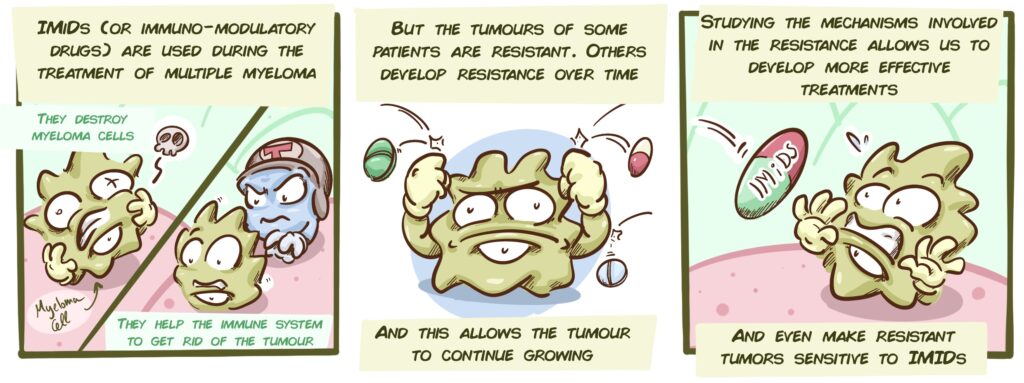Project: Resistance to treatments for Multiple Myeloma
Institution: Institute of Cancer Research, London (UK)
Researcher: Dr. Charlotte Pawlyn
What is this project about?
This research project aims to define a profile of multiple myeloma patients likely to develop resistance to myeloma treatments, study reasons why such resistance occurs and develop useful therapeutic strategies to overcome this.

What is multiple myeloma?
Multiple myeloma is a cancer that begins in the bone marrow in a type of white blood cell called a plasma cell. Plasma cells help you fight infections by making antibodies that recognize and attack germs and protect us from infections, but in this case, they behave and multiply abnormally. Multiple myeloma causes cancer cells to accumulate in the bone marrow, where they crowd out healthy blood cells.
Although a relatively rare disease, there are around 5,700 people diagnosed with myeloma in the UK and it accounts for 15 per cent of blood cancers, and two per cent of all cancers*. The biggest problem with these types of tumours is that there are currently no good curative treatments available. Most treatments are aimed at keeping the disease in check. Even so, thanks to research, the life expectancy of myeloma patients has doubled over the past decade.
*Data source: MyelomaUK
Current situation
The most widely used treatments include immunomodulatory imide drugs known as IMiDs, such as lenalidomide and thalidomide. These compounds are used to keep the disease under control after the initial treatments. They are interesting drugs. On the one hand, they eliminate the myeloma cells that gradually appear, and on the other, they promote an immune response to fight the tumour (hence the term immunomodulatory).
However, not all patients respond to them, and in those that do, tumours eventually become resistant over time. So, it is crucial to research how these resistances develop and how to overcome them.
The aim of this project
The aim is to study resistance to IMiDs through two key strands of research:
On the one hand, conduct studies into cell lines derived from myeloma. Some of these cell lines are sensitive to IMiDs, while others are resistant. Researchers also explore lines that are sensitive to IMiDs, which have been exposed to these drugs over a long period of time until they have become resistant. This allows them to compare the molecular characteristics and genetic changes of each of these lines and to see which internal alterations have made them resistant. This type of research is important and interesting because:
- It allows researchers to study new compounds in these cells and to find effective treatments against resistant myeloma cells, which can then be studied in animal models.
- It helps to identify new strategies capable of re-sensitising resistant cells to IMiDs .
- It reveals new previously unknown mechanisms of resistance
The second part of the research involves studying samples from myeloma patients treated with these drugs. Researchers will compare patients who have not developed resistance with those who have. In order to carry out this comparison, they will analyse the different proteins, genome, and other factors, in order to understand which pathways are involved in the development of resistance. One key point of this study is that samples of patients will be analysed prior to treatment. This will allow researchers to look for common elements with a view to predicting which patients will develop resistance to IMiDs. From this information, the project will define a profile of patients likely to develop resistance to myeloma and examine useful therapeutic strategies to overcome this.